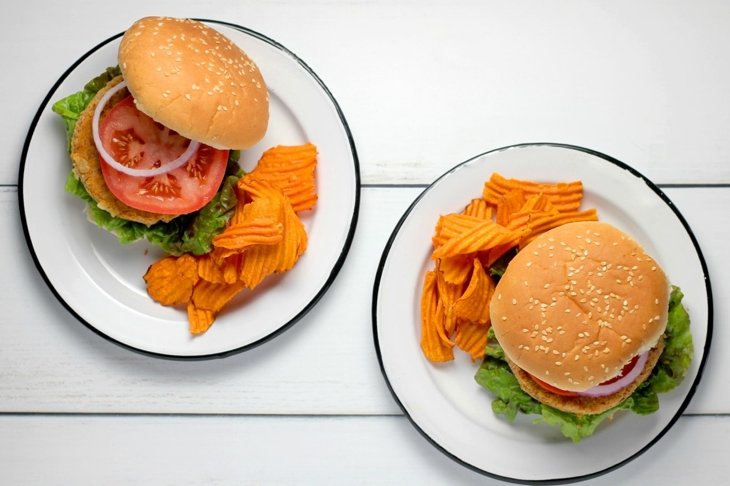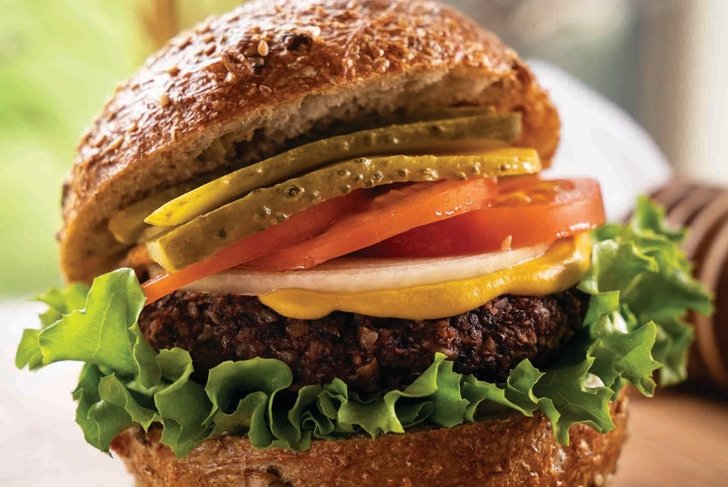
A juicy patty with all the fixings piled high on a sesame seed bun. There is something to be said for the classic burger with its iconic appearance recognized around the world and familiar, craveable taste enjoyed in places far beyond North America.
Fast food chains have made hamburgers an everyday indulgence, and many have recently introduced a new take on the traditional composition that’s piqued the curiosity and whetted the appetite of millions: the plant-based fast food burger. Still as portable and mouthwatering as its meaty inspiration, but created by scientists rather than chefs, this burger is said to be the future of fast food—and consumers are listening.
But is a truly healthy, environmentally conscious fast food vegan burger all good? Or is it too good to be true?
Let’s take a closer look
Touted as a healthier fast food option, and marketed as the wholesome and environmentally conscious choice for diners on the go, the plant-based burgers of today are a far cry from the bland, dry, and crumbly patties of the last 30 years, offering a “real” burger experience, hold the beef.
Besides mostly rave reviews on their texture and flavour, these burgers are helping lead the way in making meatless meals mainstream, assisting consumers in making more informed choices when it comes to what they’re eating on a larger scale. They’re also helping to dissolve the exclusivity of vegan eating, a feature of the lifestyle and diet that has been criticized as a privilege available to only those who can afford it. (Nevertheless, it should be noted that these burgers are some of the most expensive items on a fast food menu.)
Of course, the products are not without controversy. Since they’re so new to the market, there is little research on the long-term effects of a diet heavy in processed plant-based meat alternatives, making moderation key. And many see them as too highly processed to be marketed as a healthy option.
Are they healthy?
One of the most popular and well-reviewed plant-based fast food burgers leading the trend is the Beyond Meat patty. The patty does contain large amounts of pea protein isolate, rice protein, vitamins, and minerals, and its beefy red hue comes naturally from beet and pomegranate, but it’s also pumped up with less impressive characters such as refined coconut oil and maltodextrin.
But the patty’s ingredient list looks squeaky clean compared to fast food chains’ additions, such as seasoning mix with silicon dioxide and caramel colour and the glucose/fructose-laden burger buns. And when you bite into one of these fast food plant-based burgers, you’re likely biting into a salt bomb—with salt added into every additional ingredient. Although none of this is stopping consumers from lining up—the Beyond Meat burger has hit the mainstream.
In a home context, where you can control the quality of the bun, toppings, and seasoning, the Beyond Meat patties are a healthier option. You can now cook them up in your own kitchen, with Beyond Meat and its competitors now widely available at major grocery stores. It’s those fast food extras (meaning preservatives and additives) that lessen its appeal for real food fans.
These burgers do, however, raise awareness about eating more plant-based foods in general, potentially inspiring diners to try a new vegan recipe, buy a vegan cookbook, or simply be excited about incorporating more delicious meatless meals into their life. All of this may contribute to overall health.
North Americans are adventurous eaters who want choice, and plant-based burgers give them that. But with choice comes fries, which you will probably order with your “healthy” burger, giving the illusion of balance.
Tip: Wall Street goes meatless
The world of finance has taken note of the plant-based burger trend, too. In the last year, the stock price of Beyond Meat, Inc., the company behind the popular Beyond Meat burger, debuted on the market at US$46 in May 2019. Upon closing on July 26, 2019, the stock price rose to a high of US$234.90. The benefit of taking Beyond Meat public is that these companies have to please investors, many of whom are frequent consumers, to keep their stock price momentum positive.
What about taste and texture?
The question everyone, even non-vegans, wants answered: how does it taste? This spirit of adventure is part of their popularity. The Impossible Burger, one of the major names in the plant-based patty world, contains genetically engineered heme, which Impossible claims is responsible for its meaty flavour. This heme also contributes to its “bloody” pink interior, serving as an uncanny twin to a medium-rare beef burger.
Tip: Is the GM heme in Impossible Burgers safe?
Yes, according to the US Food and Drug Administration (FDA), which has approved soy leghemoglobin, the genetically modified ingredient that makes the Impossible Burger appear as though it is “bleeding,”as safe to eat.
The Impossible Burger has been described as having a meaty, umami taste with a pleasing chew (yes, like beef). The taste and texture satisfies like beef, and the high protein count makes it feel substantial. Note that these are meat substitutes, not homespun veggie burgers (so don’t expect to taste or detect carrots, beans, and rice in there).
Many vegans and vegetarians are turned off by their meat-adjacent flavour, texture, and appearance, but that’s not of concern to these companies. The majority chowing down on plant-based fast food burgers are meat eaters (omnivores), not vegans or vegetarians—an estimated 95 percent of the consumer base for Beyond Meat.
Tip: New and “improved”?
If the GM heme in the Impossible Burger isn’t a deal breaker, the revamped 2019 Impossible Burger 2.0 is now gluten free, allowing an even greater audience to enjoy a vegan burger (assuming they’re okay with its GMOs). It’s also now lower in saturated fat, with some of the coconut oil being replaced with sunflower oil.
Big, bold environmental claims
Industrialized animal agriculture is a major contributor to greenhouse gases. Recent research estimates that beef results in up to 105 kg of greenhouse gases per 100 g of protein. Tofu, by contrast, produces a tiny fraction of that.
Tip: Beef farming that’s good for the environment?
Not all beef is created equal when it comes to environmental impact. While it’s true that several fast food chains have come under scrutiny for sourcing beef from Brazil, where it’s linked to Amazon rainforest deforestation, recent research suggests that regenerative methods used in holistically managed, pasture-raised beef farming may actually positively contribute to the environment.
What are “regenerative methods”? Check out our article about regenerative agriculture.
If you’re a meat eater, you don’t have to give all meat up to make a positive impact on the environment: eating just one vegetarian meal per week could save the equivalent of driving 1,160 miles (1,867 kilometres). Of course, the question we’re looking to answer is if plant-based fast food burgers can fit into this definition of an environmentally friendly vegetarian meal.
The major plant-based burger companies have made sweeping claims about how their products are better for the environment than beef, but there are few places to turn for third-party facts. Both Impossible Burger and Beyond Burger commissioned the major studies attached to their product.
While the food packaging is noted as an environmental concern in the Beyond Meat study, the same study reported positively in terms of the eco-friendly nature of the plain patties themselves (without the bun, seasonings, and condiments applied in a fast food setting). The Impossible Burger study also weighed in favour of their patties over beef patties in terms of eco-benefits.
Consumers do need to take this information with a grain of salt—the two studies were commissioned by the companies themselves, which raises several red flags. Before the environmental debate of beef burger versus fast food plant-based burger is settled, additional studies are needed, preferably without the plant-based burger companies paying for the reporting.
So what’s the verdict?
As with burgers in general, view these burgers as a “sometimes” food or a treat, not an everyday option but a choice that is helping us evaluate how we eat and what we are eating. For that reason, we can see plant-based fast food burgers as a baby step in the right direction, but certainly not a panacea to the fast food burger industry’s disagreeable human health and environmental effects.
The right questions are being asked by demanding consumers and health professionals, and it’s up to these large companies to remain accountable and transparent, and to keep striving to complete this mission impossible.
How to build a better burger
If you’re in search of a middle ground between the fast food varieties and dry, carbohydrate-heavy homemade patties, the solution is a new kind of DIY burger. Unlike its fast food counterparts, the Homemade Plant-Based Possible Burger is a truly economical, healthy, and environmentally friendly option. Instead of a classic grain- and bean-heavy, made-by-you patty, you’ll find a richer base of sunflower seeds and a flavour profile built around umami.
Homemade Plant-Based Possible Burger































